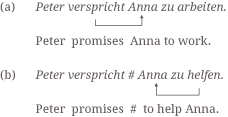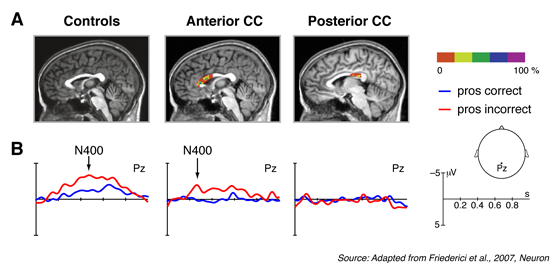Interaction of syntax and prosody: The role of the corpus callosum
Syntax and prosody interact during language comprehension. This has been demonstrated in behavioral studies (Marslen-Wilson et al., 1992; Warren, Grabe & Nolan, 1995). The neurocognitively interesting question is what the neural basis of this interaction. We know syntax is mainly processed in the left hemisphere and prosody mainly in the right hemisphere. We further know that the two hemispheres are neuroanatomically connected via the corpus callosum (CC) (Hofer & Frahm, 2006; Huang et al., 2005). Therefore, the CC is a good candidate to provide the neural basis for the interaction. Patients with a lesion to the CC might give us insight with respect to this issue, when confronting them with sentences in which syntactic information and prosodic information do not match (as in sentence (c)).
“An interaction of prosodic and syntactic information can be observed when it comes to assign relations between a verb and its arguments. For example, in the following prosodically correct German sentences as in (a) in which “Anna” is the object of “promise” and (b) in which “Anna” is the object of “help”:

Due to German word order, the two sentences appear identical up to the word “zu”, but their syntactic structure is marked differently by intonation (indicated by # marking the IPB). Sentence (a) becomes prosodically incorrect as in (c) by inserting the IPB after the verb as in (b). In (c) the prosodic information signals that “Anna” is the object of the following verb “arbeiten”, but the verb arbeiten/work cannot take a direct object.

(see Friederici, 2011)
In healthy listeners prosodically incorrect sentences as in (c) elicit a particular pattern in the electrophysiological event-related brain potential (Steinhauer, Alter & Friederici, 1999; Bögels et al., 2010).
In order to test whether the CC provides the neural basis for the prosody-syntax interaction sentences (a), (b) and (c) were presented to patients with lesions in the CC. Healthy controls and in patients with lesions in the anterior CC revealed, but not patients with lesions in the posterior CC showed a prosody-syntax mismatch effect (N400) (Friederici, von Cramon & Kotz, 2007) (see Fig. 12). This finding provides clear evidence for the view that the interaction of prosody and syntax relies on the posterior portion of the CC through which the temporal cortices of the left hemisphere and the right hemisphere are connected.

Figure 12: Prosody mismatch effect at critical verb
Effects for healthy participants (controls) and patients with lesions in the anterior or posterior portion of the corpus callosum (CC). A: Lesion density maps of anterior versus posterior lesion contributions in the CC. Midsagital (top and middle) and axial (botton) slices are shown, cutting the location of maximal lesion overlap. For each voxel, the percentage of lesion overlap is depicted. The color scale shows five levels: each bar represents 20% increments. B: ERPs (grand average) at the critical verb in the sentence for the prosodically correct (blue) and incorrect (red) sentence phrasing. Figure Legend taken from Friederici, 2011 (Physiological Reviews, 91(4), 1357-1392).